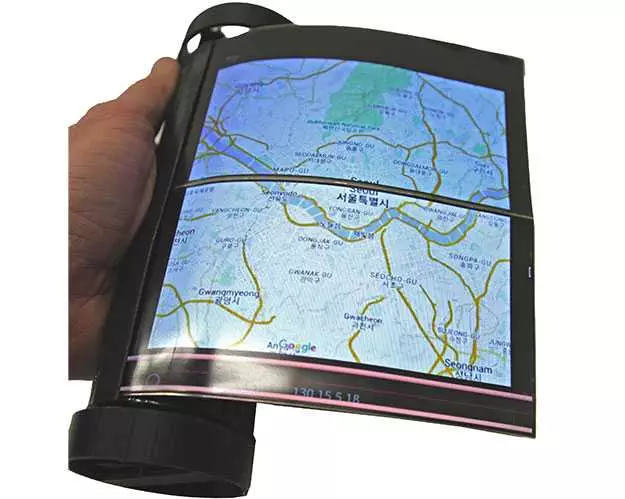We’ve reached a point where it seems like there will be no groundbreaking innovations in smartphones or tablets. Sure, screen quality continues to improve, and each update to the camera blows away expectation, but the basic format for these devices seems set. Manufacturers have experimented with tiny smartphone screens and large smartphone screens, what else can they do?
If researchers at Queen’s University in Ontario, Canada, are to be believed, the answer is actually “plenty.” A research team developed MagicScroll, a cylindrical touchscreen device that actually unfurls into a 7.5 inch OLED display. Although it looks a bit flimsy, as a prototype it looks pretty impressive. The screen is clear and sharp and it completely reimagines the way we interact with a handheld device.
MagicScroll changes the game from square tablets and smartphones to something that is fully five-dimensional. There are physical dials on both ends that are used to scroll the device in cylinder mode, changing the way people interact with their device. The MagicScroll was made from two LG G Flex 2 displays measuring 2160 x 1920. In other words, these are two 5.5-inch Flex 2 displays spliced together, and a 3D-printed cylindrical body. The guts of the machine are two Android circuit boards, which run Android 5.1 Lollipop, along with three lithium-ion batteries. Two of the batteries are at 600mAh and are used to power the system. There is also a 300mAh battery to turn the actuated wheels on either side of the scroll. The rest are the usual component parts that are used in smartphones and tablets.

Although the MagicScroll may never be in production, the researchers believe that the future of smartphone technology lies in cylindrical screens and bendable holograms. The Queens University team has experimented with Organic User Interfaces, focusing on different shapes than the usual rectangle, as well as modes of display. Their first product was ReFlex, a smartphone featuring a flexible display. When the ReFlex is bent down, pages flipped through the fingers from right to left, mimicking the way you read a book. The more extreme the bend, the faster the page flip. In addition, users can actually feel the sensation of a page moving through the fingertip because the phone vibrates.

They have also created a Holoflex, which renders holographic images through being bent and manipulated by the user. Users don’t need to use 3D glasses to see the holographic properties.
Additionally, the research team came up with the MagicWand, which is a cylindrical interface that has users rotating it to see a gaming character from all sides, as if it were fully 3D. The research team points out that smartphones are flat and aren’t great for gaming. They make weak controllers. MagicWand, on the other hand, is the very first handheld device with a 340-degree hi res display that has the same movement capability of a pointer stick.
There is no doubt that these devices would change the way that handheld devices are manipulated, requiring a learning curve for the user. Does this appeal to you? Do you think that the MagicScroll would be as intuitive as the smartphone? Comment below.
